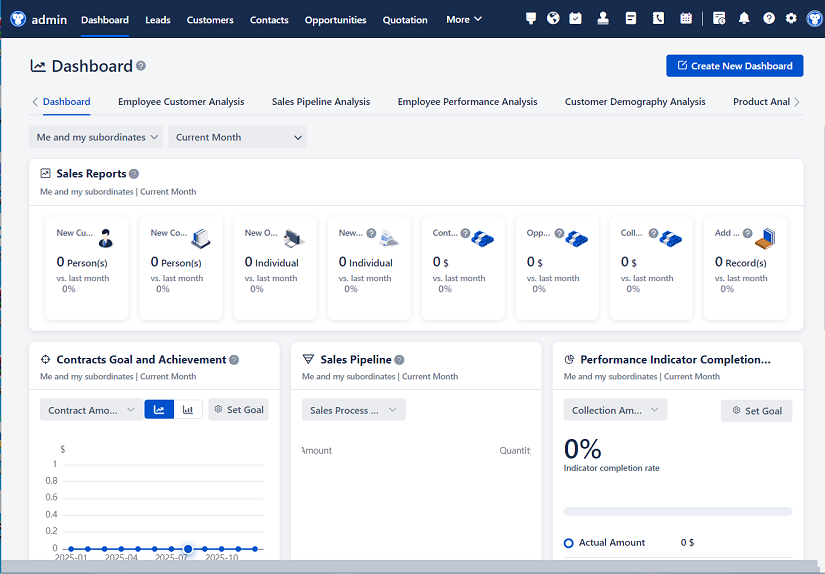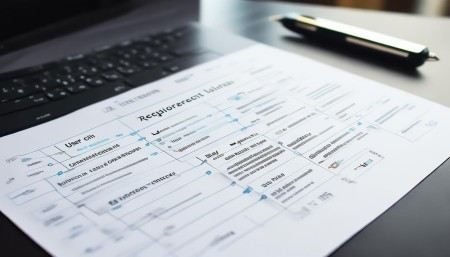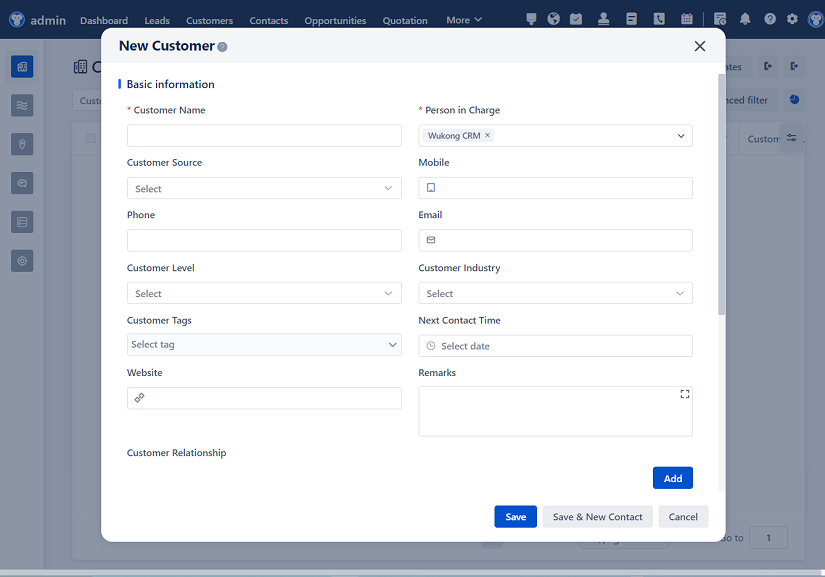
△Click on the top right corner to try Wukong CRM for free
Understanding the Necessity of a CRM System
Hey there! So, you're thinking about getting a CRM (Customer Relationship Management) system for your business. That's a great idea! A CRM can really help you keep track of all your customer interactions and make sure everyone in your team is on the same page. But before you dive in, it’s super important to figure out exactly what you need from this system. That’s where a CRM Requirements Specification comes in.
What Is a CRM Requirements Specification?
Alright, let me break it down for you. A CRM Requirements Specification is basically a detailed document that outlines everything you want your CRM system to do. It’s like making a shopping list, but instead of groceries, you’re listing out all the features and functionalities you need. This document helps you and your team stay focused and ensures that the CRM you end up with is the perfect fit for your business.
Why Do You Need a CRM Requirements Specification?
Well, imagine you go to a store without a list. You might end up buying things you don’t need and forgetting the essentials. The same goes for a CRM. Without a clear set of requirements, you might end up with a system that doesn’t meet your needs, or worse, one that’s too complicated and ends up being more of a hassle than a help. A good requirements specification will save you time, money, and a lot of headaches down the line.

Key Components of a CRM Requirements Specification

So, what should you include in your CRM Requirements Specification? Let’s go through some of the key components:
1. Business Objectives
First things first, you need to define what you want to achieve with your CRM. Are you looking to improve customer retention, increase sales, or maybe streamline your customer service? Whatever it is, write it down. This will be your North Star, guiding every decision you make about the CRM.

2. User Roles and Permissions
Next, think about who will be using the CRM and what they need to do. For example, your sales team might need access to customer contact information and sales history, while your marketing team might need to see campaign performance data. Make sure to outline the different user roles and the permissions each role should have. This will help keep your data organized and secure.

3. Core Features and Functionalities
Now, let’s talk about the meat and potatoes of your CRM. What specific features do you need? Maybe you want a system that can handle email marketing, or one that integrates with your existing tools like your accounting software. List out all the core features and functionalities that are essential for your business. Don’t forget to include any nice-to-haves as well, just in case you find a CRM that can do even more than you expected.
4. Data Management and Integration
Data is the lifeblood of any CRM, so you need to think about how you’ll manage it. How will you import your existing customer data into the new system? Do you need to integrate with other tools, like your website or e-commerce platform? Make sure to specify any data management and integration requirements. This will ensure that your CRM can seamlessly work with your current setup.
5. Customization and Scalability
Every business is unique, so you might need a CRM that can be customized to fit your specific needs. Think about whether you need custom fields, workflows, or reports. Also, consider the future. Will your CRM be able to scale as your business grows? You don’t want to outgrow your CRM in a year or two, so make sure it has the flexibility to grow with you.

6. Security and Compliance
Security is a big deal, especially when it comes to customer data. You need to make sure your CRM is secure and complies with all relevant regulations, like GDPR or HIPAA. Outline any security and compliance requirements you have, such as data encryption, access controls, and audit trails. This will help protect your business and your customers’ data.
7. User Experience and Training
Finally, think about the people who will be using the CRM. It’s no good if it’s too complicated or hard to use. Specify any user experience requirements, like an intuitive interface or mobile access. Also, consider training. Will you need onboarding and ongoing support? Make sure to include these in your requirements to ensure a smooth transition.
Creating Your CRM Requirements Specification
Okay, now that you know what to include, let’s talk about how to create your CRM Requirements Specification. Here are some steps to get you started:
-
Gather Input from Stakeholders: First, talk to the people who will be using the CRM. Get their input on what they need and what would make their jobs easier. This could be your sales team, customer service reps, or even your IT department. The more input you get, the better your requirements will be.
-
Prioritize Your Needs: Once you have a list of requirements, prioritize them. What are the must-haves, and what are the nice-to-haves? This will help you focus on the most important features and make sure you don’t miss anything critical.
-
Write a Clear and Concise Document: Now it’s time to put it all together. Write a clear and concise document that outlines all your requirements. Use simple language and avoid jargon. This will make it easier for everyone to understand and follow.

-
Review and Revise: Before you finalize your requirements, review them with your stakeholders. Make sure everyone agrees and that nothing important has been left out. This is also a good time to get feedback and make any necessary revisions.
-
Get Approval: Finally, get approval from the key decision-makers in your organization. This could be your CEO, CTO, or whoever is responsible for approving new technology. Make sure they understand the benefits and are on board with the plan.

Benefits of a Well-Defined CRM Requirements Specification
Having a well-defined CRM Requirements Specification can bring a ton of benefits to your business. Here are a few:
-
Clear Expectations: Everyone knows what to expect from the CRM, which reduces confusion and miscommunication.

-
Better Decision-Making: With a clear set of requirements, you can make informed decisions about which CRM to choose and how to implement it.

-
Cost Savings: By knowing exactly what you need, you can avoid overspending on unnecessary features and reduce the risk of costly mistakes.
-
Improved User Adoption: When the CRM meets the needs of your users, they’re more likely to use it and get the most out of it.
-
Future-Proofing: A well-thought-out requirements specification can help ensure that your CRM is scalable and can adapt to your business as it grows.
Common Pitfalls to Avoid
While creating a CRM Requirements Specification, there are a few common pitfalls to watch out for:
-
Overcomplicating Things: Keep it simple. Don’t overcomplicate your requirements with too many details or overly technical language. This can make it harder to understand and follow.
-
Ignoring User Feedback: Make sure to involve the people who will be using the CRM. Ignoring their input can lead to a system that doesn’t meet their needs and is difficult to use.
-
Failing to Prioritize: Prioritize your requirements. Focusing on the most important features will help you make better decisions and avoid getting overwhelmed.

-
Not Considering Future Needs: Think about the future. Your CRM should be able to grow with your business, so make sure to include scalability and flexibility in your requirements.

-
Neglecting Security and Compliance: Security and compliance are crucial. Don’t neglect these aspects, as they can have serious consequences for your business and your customers.
Conclusion
Creating a CRM Requirements Specification might seem like a lot of work, but trust me, it’s worth it. A well-defined set of requirements will help you choose the right CRM, implement it smoothly, and get the most out of it. Remember to involve your stakeholders, prioritize your needs, and keep it simple. With a little effort upfront, you’ll end up with a CRM that truly works for your business.

Q&A
Q: What is the main purpose of a CRM Requirements Specification? A: The main purpose is to clearly outline what you need from your CRM system, ensuring that it meets your business objectives and user needs. It helps you make informed decisions and avoid costly mistakes.
Q: Who should be involved in creating the CRM Requirements Specification? A: You should involve all the key stakeholders, including the sales team, customer service reps, IT department, and anyone else who will be using the CRM. Their input is crucial for creating a comprehensive and effective set of requirements.
Q: How often should I update my CRM Requirements Specification? A: It’s a good idea to review and update your requirements periodically, especially as your business grows and changes. This will help ensure that your CRM continues to meet your evolving needs.
Q: Can I use a template for my CRM Requirements Specification? A: Absolutely! Using a template can be a great way to get started. Just make sure to customize it to fit your specific needs and business context.
Q: What happens if I skip the CRM Requirements Specification step? A: Skipping this step can lead to a CRM that doesn’t meet your needs, is difficult to use, and may require significant rework later on. It’s much better to invest the time upfront to get it right.
I hope this helps you get started on your CRM journey! If you have any more questions, feel free to ask. Good luck!
Related links:
Free trial of CRM
Understand CRM system
AI CRM Systems

△Click on the top right corner to try Wukong CRM for free